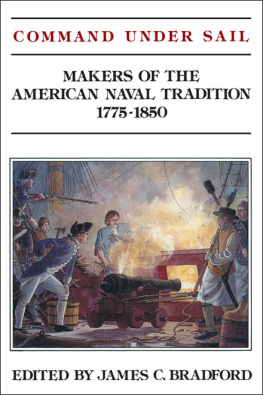Quarterdeck and Bridge
This book has been brought to publication with the generous assistance of Marguerite and Gerry Lenfest.
Quarterdeck
and Bridge
Two Centuries of
AMERICAN NAVAL LEADERS
EDITED BY JAMES C. BRADFORD
NAVAL INSTITUTE PRESS  ANNAPOLIS, MARYLAND
ANNAPOLIS, MARYLAND
This book has been brought to publication by the generous assistance of Marguerite and Gerry Lenfest.
1997 by the U.S. Naval Institute,
Annapolis, Maryland
All rights reserved. No part of this book may be reproduced without written permission from the publisher.
LIBRARY OF CONGRESS CATALOGING-IN-PUBLICATION DATA
Quarterdeck and bridge : two centuries of American naval leaders / edited by James C. Bradford.
p. cm.
Includes bibliographical references and index.
ISBN 978-1-6125-1262-4
1. United States. NavyBiography. 2. United StatesHistory, Naval. I. Bradford, James C.
E182.Q37 1996
359.0092273dc20
[B] 96-43106
William M. Fowler, Jr., Esek Hopkins; James C. Bradford, John Paul Jones; John H. Schroeder, Stephen Decatur; John K. Mahon, Oliver Hazard Perry; and Harold D. Langley, Robert F. Stockton, appeared in slightly different forms in James C. Bradford, ed., Command under Sail: Makers of the American Naval Tradition, 17751850 (Annapolis: Naval Institute Press, 1985).
John H. Schroeder, Matthew Calbraith Perry; William N. Still, Jr., David Glasgow Farragut; Warren F. Spencer, Raphael Semmes; and Tamara Moser Melia Smith, David Dixon Porter, appeared in slightly different forms in James C. Bradford, ed., Captains of the Old Steam Navy: Makers of the American Naval Tradition, 18401880 (Annapolis: Naval Institute Press, 1986).
John B. Hattendorf, Stephen B. Luce; Vernon L. Williams, George Dewey; David F. Trask, William Sowden Sims; and Clark G. Reynolds, William A. Moffett, appeared in slightly different forms in James C. Bradford, ed., Admirals of the New Steel Navy: Makers of the American Naval Tradition, 18801930 (Annapolis: Naval Institute Press, 1990), as did a much longer version of Robert Seager II, Alfred Thayer Mahan.
Lloyd J. Graybar, Ernest J. King; John B. Lundstrom, Chester W. Nimitz; John F. Wukovits, William F. Halsey; David Alan Rosenberg, Arleigh Burke; Francis Duncan, Hyman G. Rickover; and Thomas J. Cutler, Elmo R. Zumwalt, Jr., were written especially for this volume.
For Judy
Contents
WILLIAM M. FOWLER, JR.
JAMES C. BRADFORD
JOHN H. SCHROEDER
JOHN K. MAHON
HAROLD D. LANGLEY
JOHN H. SCHROEDER
WILLIAM N. STILL, JR.
WARREN F. SPENCER
TAMARA MOSER MELIA SMITH
JOHN B. HATTENDORF
ROBERT SEAGER II
VERNON L. WILLIAMS
DAVID F. TRASK
CLARK G. REYNOLDS
LLOYD J. GRAYBAR
JOHN B. LUNDSTROM
JOHN F. WUKOVITS
DAVID ALAN ROSENBERG
FRANCIS DUNCAN
THOMAS J. CUTLER
STRATEGICALLY AN ISLAND, THE UNITED STATES HAS ALWAYS REQUIRED A NAVY to bar enemies from its shores. Economically a trading nation, it has also needed a navy to defend its trade. The size and type of navy have always been debated. So has the way in which a navy should carry out its responsibilities. Prior to the twentieth century, the U.S. Navy did not need to exercise command of the sea or naval mastery, or even to vie for such exalted strategies, but it had a key role to play in defense of the Republic and the protection and expansion of its commerce.
The Continental Navy was established during the Revolutionary War with the anticipation that it could help win independence and because Americans knew that sovereign nations have navies. Similar thoughts led most of the states to establish navies of their own and both state and national governments to license privateers. The nations founders did not discuss naval strategy. They simply assigned tasks to the fledgling servicecapture supplies for George Washingtons army, transport diplomats to Europe, bring munitions from the West Indies, raid British commerce, help to defend American portsand the officers of the navy responded as best they could with the limited resources available to them. Independence achieved, many Americans believed that a navy was no longer needed or at least that the nation could not afford one. For a decade, the Stars and Stripes were carried to sea only by merchant vessels.
When attacks on those trading vessels became more than Americans could bear and a new constitution gave the government the ability to support a navy, one was reestablished. At virtually the same time, Europe returned to war. Coalitions led by Britain and France fought a life-and-death struggle, in which neither side showed much respect for the rights of neutral commerce espoused by the United States. The young Republic was not a passive observer of that great war but followed a policy of belligerent neutrality, which twice led it into the European conflict, first into the Quasi-War against France, then into the War of 1812 against Britain. Because the war with France was conducted entirely at sea, the burden of defense fell on the U.S. Navy. The war against Britain was fought equally on land and sea, but it was the Navys frigate actions in 1812 that avenged the nations honor and earned its enemys respect, and its victories on Lakes Erie and Champlain in 1813 and 1814 that helped to secure the status quo antebellum Treaty of Ghent, which ended the war.
During the decades following peace with Britain, the United States obtained Florida, settled its northern and western borders, and marked the Caribbean as within its sphere of influence. The Monroe Doctrine proclaimed the principles of U.S. foreign policy to the rest of the world, and Britain gave tacit recognition to the equality of U.S. interests and authority in the Western Hemisphere by signing the Clayton-Bulwer Treaty in 1850.
It fell to the U.S. Navy to execute this policy and to protect American commercial interests around the world. From the 1770s to the 1840s, most of the Navys squadrons, cruising the Atlantic, Mediterranean, and Caribbean, showed the flag, and suppressed piracy and the slave trade. When periodic visits by naval vessels failed to deter infringement of American rights, officers turned to retribution and punished those who mistreated shipwrecked mariners, seized the property of merchants, discriminated against American commerce, or dishonored the American flag.
During the 1850s, various interest groups demanded that the Navy do more and its officers eagerly accepted increased responsibilities. The Navys role was expanded from merely defending commerce to exploring new lands and trade routes, identifying opportunities for trade, collecting nautical and commercial information, negotiating diplomatic agreements, and opening areas previously closed to American merchants. Matthew F. Maurys collection of data on wind and ocean currents; Charles Wilkess United States Exploring Expedition of 183842; Matthew Calbraith Perrys opening of Japan and conclusion of the Treaty of Kanagawa in 1854; the North Pacific Surveying and Exploring Expedition of 185355; and Robert Shufeldts globe-encircling voyage of 187880, during which he opened U.S. trade relations with Korea, epitomize these new roles.
Next page










 ANNAPOLIS, MARYLAND
ANNAPOLIS, MARYLAND